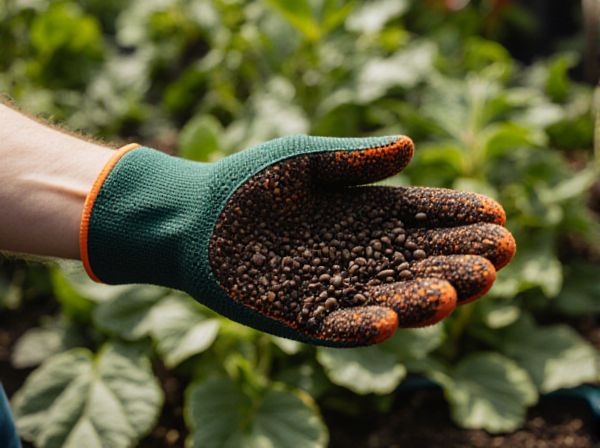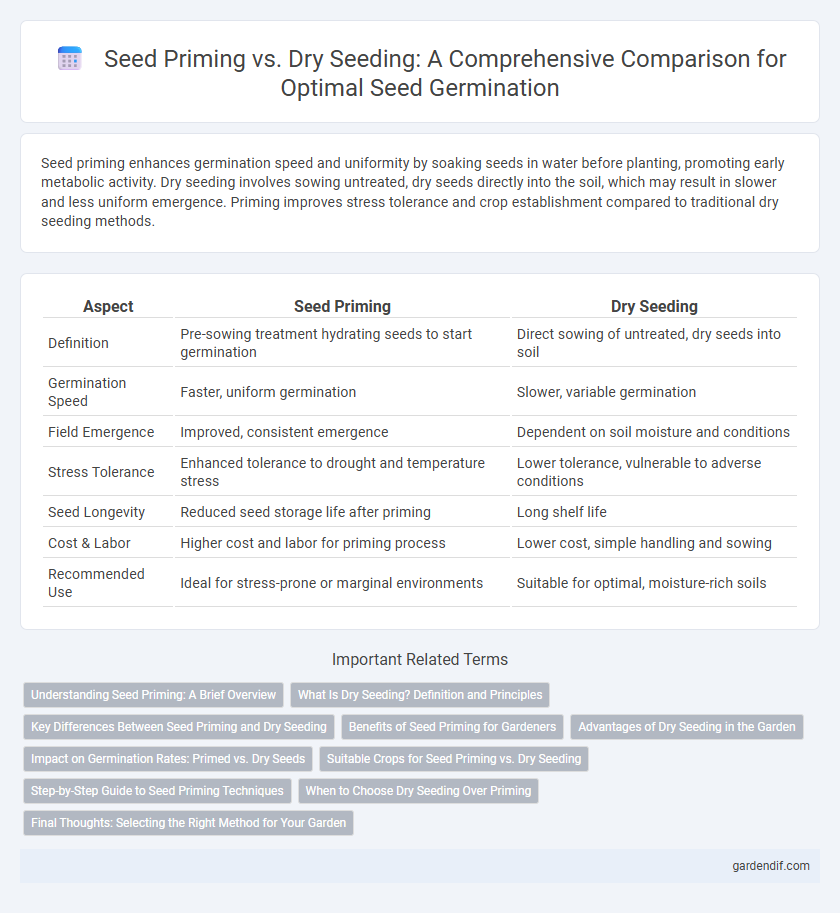
Seed priming vs Dry seeding Illustration
Seed priming enhances germination speed and uniformity by soaking seeds in water before planting, promoting early metabolic activity. Dry seeding involves sowing untreated, dry seeds directly into the soil, which may result in slower and less uniform emergence. Priming improves stress tolerance and crop establishment compared to traditional dry seeding methods.
Table of Comparison
| Aspect | Seed Priming | Dry Seeding |
|---|---|---|
| Definition | Pre-sowing treatment hydrating seeds to start germination | Direct sowing of untreated, dry seeds into soil |
| Germination Speed | Faster, uniform germination | Slower, variable germination |
| Field Emergence | Improved, consistent emergence | Dependent on soil moisture and conditions |
| Stress Tolerance | Enhanced tolerance to drought and temperature stress | Lower tolerance, vulnerable to adverse conditions |
| Seed Longevity | Reduced seed storage life after priming | Long shelf life |
| Cost & Labor | Higher cost and labor for priming process | Lower cost, simple handling and sowing |
| Recommended Use | Ideal for stress-prone or marginal environments | Suitable for optimal, moisture-rich soils |
Understanding Seed Priming: A Brief Overview
Seed priming enhances germination by pre-soaking seeds to activate metabolic processes before planting, improving seedling vigor and uniformity. Dry seeding involves sowing untreated seeds directly into the soil, which can result in slower, less uniform germination under adverse conditions. Understanding the physiological benefits of seed priming helps optimize crop establishment and yield, especially in challenging environments.
What Is Dry Seeding? Definition and Principles
Dry seeding is the agricultural practice of sowing untreated seeds directly into dry soil without prior soaking or priming, relying on natural soil moisture for germination. This method conserves seed handling time and reduces labor costs, particularly suitable for regions with unpredictable rainfall patterns. Its principles center on minimal seed preparation, allowing seeds to absorb moisture gradually after planting, which can lead to variable germination rates compared to seed priming techniques.
Key Differences Between Seed Priming and Dry Seeding
Seed priming enhances germination by pre-soaking seeds in water or osmotic solutions, allowing metabolic activation before sowing, whereas dry seeding involves planting untreated, dry seeds directly into the soil. Seed priming improves uniformity, stress tolerance, and seedling vigor, resulting in faster emergence and higher stand establishment compared to dry seeding. Dry seeding is simpler and less resource-intensive but often leads to slower germination and lower crop yield potential under suboptimal conditions.
Benefits of Seed Priming for Gardeners
Seed priming enhances germination rates by pre-soaking seeds, allowing faster and more uniform sprouting compared to dry seeding. This technique improves seedling vigor and stress tolerance, making plants more resilient to drought and temperature fluctuations. Gardeners benefit from reduced seed wastage and higher crop yields through optimized early growth conditions.
Advantages of Dry Seeding in the Garden
Dry seeding offers significant advantages in the garden, including faster planting as seeds are sown directly without pre-soaking or treatment, which saves time and labor. It reduces the risk of seed damage or disease that can occur during priming processes, promoting healthier seedling emergence. Additionally, dry seeding allows for more precise sowing depth and spacing, optimizing germination rates and garden productivity.
Impact on Germination Rates: Primed vs. Dry Seeds
Seed priming significantly enhances germination rates by initiating metabolic processes before sowing, leading to faster and more uniform seedling emergence compared to dry seeding. Primed seeds absorb water to trigger enzymatic activity without allowing radicle protrusion, which improves germination speed and stress tolerance. In contrast, dry seeds rely solely on environmental moisture post-sowing, often resulting in slower and less consistent germination under suboptimal conditions.
Suitable Crops for Seed Priming vs. Dry Seeding
Seed priming is especially suitable for vegetables like tomatoes, peppers, and cucumbers, as well as cereals such as wheat and barley, enhancing germination speed and uniformity. Dry seeding works best for large-seeded crops like maize, soybeans, and cotton, where seed coating or soaking is less critical for uniform emergence. Seed priming benefits small-seeded and stress-sensitive crops by improving initial seed metabolism, whereas dry seeding suits robust seeds that can germinate well without pre-treatment.
Step-by-Step Guide to Seed Priming Techniques
Seed priming enhances germination by soaking seeds in water or nutrient solutions before sowing, improving seed vigor and uniform emergence. Begin by selecting high-quality seeds, then soak them for 6-12 hours in aerated water or specific priming agents like potassium nitrate or gibberellic acid, followed by drying to original moisture content. This controlled hydration activates metabolic processes without radicle protrusion, unlike dry seeding where seeds are sown directly without pre-treatment, often resulting in slower and less uniform germination.
When to Choose Dry Seeding Over Priming
Dry seeding is preferred over seed priming in environments where rapid field operations and minimal labor inputs are critical, such as during large-scale planting or unfavorable weather conditions that hinder seed treatment processes. This method reduces the risk of seed damage and storage complications associated with pre-moisturized seeds, making it ideal for crops like wheat and barley in arid or variable climates. Selecting dry seeding ensures seed viability is maintained without the need for immediate sowing, offering flexibility in planting schedules.
Final Thoughts: Selecting the Right Method for Your Garden
Seed priming enhances germination speed and uniformity by hydrating seeds before planting, ideal for controlled environments and ensuring faster seedling establishment. Dry seeding allows direct sowing without treatment, suitable for larger scale or less controlled conditions where simplicity and cost-effectiveness are priorities. Choosing between seed priming and dry seeding depends on garden size, desired germination efficiency, and resource availability to optimize crop performance.
Seed priming vs Dry seeding Infographic

 gardendif.com
gardendif.com